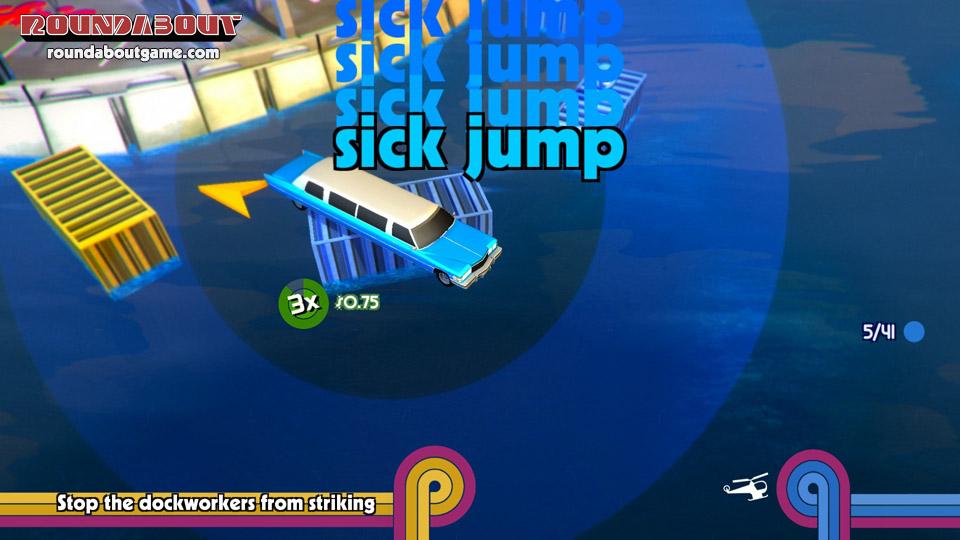“No Goblin’s open-world puzzle game puts the player in control of a spinning limousine, and things only get weirder from there.”
- Live-action cutscenes provide lots of humor
- Plenty of satisfying moments nailing a tough jump or winding around moving obstacles
- Bizarre premise really stands out
- Most of the game can be explored in a few short hours
- Even after unlocking new abilities, navigating a spinning limo can be frustrating
Roundabout is an open-world puzzle game about Georgio Manos, the world’s first “revolving chauffeur.” If that premise sounds ridiculous, the gameplay itself is even sillier. Using live-action cutscenes and ’70s-style titles and voiceover, Georgio’s rotating escapades take her all around the city of Roundabout, usually with a strange passenger or two in tow. In turns challenging and frustrating, Roundabout is consistently funny and just bizarre enough to stand out in the crowded downloadable games market.
Aside from the spinning limo, Roundabout almost looks like a run-of-the-mill top-down driving game at first glance. There’s a mini-map in the corner that can be expanded on the pause screen, plenty of pedestrians just waiting to be run over, and other cars driving haphazardly. If you’re picturing a gritty GTA-esque city, though, Roundabout is quite the opposite: the cartoony world pops with color, from the cars to the environment to the blood-spatter on the streets after you’ve gleefully mowed down a wave of bystanders.
Roundabout is consistently funny and just bizarre enough to stand out.
You might even be tempted to play Roundabout like an old-school driving game just out of habit. And you’d fail. Roundabout is most certainly not a driving game.
Simply trying to move from point A to point B while controlling an elongated, rotating automobile is a recipe for disaster, and early missions can be frustrating. After a few rounds behind the wheel, the puzzle aspect becomes more clear, and it’s easier to understand just how to control Georgio’s car. You’ll instinctually figure out when to slow down, when to speed up, and when to jump. And just when you think you’ve got the hang of it, you’ll hit a tree and explode.
The rotating limo is fairly limited at first, as far as spinning cars go. By hitting certain goals or story points, more upgrades and abilities are gained, like being able to jump onto buildings or drive on water. Despite having a fair amount of skills to unlock, however, the entire game can be played sticking to the basics, and none of the later abilities are as handy as slowing down time, the first power-up available. And since you can only have one power-up equipped at a time – they can be swapped at repair shops – there’s not much incentive to switch around, other than giving new abilities a quick test drive.
Though the map is fairly open, there’s not a ton of stuff to do at any given time. Once you’ve made some money, you can customize Georgio’s vehicle or buy some real estate, which keeps more cash rolling in. The campaign itself follows a linear trajectory, with driving missions loosely strung together by a silly but enjoyable story in which Georgio learns how to drive competently, defeats a rival, and finds true love, among other things.
All of this is revealed in live-action videos starring Kate Welch as Georgio and featuring familiar faces from the games industry as her passengers. The story sequences are ridiculous, but they’re also very charming—even when you’re helping a priest track down a runaway groom or being encouraged to commit murder by a hallucinatory skeleton.
The rotating limo is fairly limited at first, as far as spinning cars go.
Each mission is loaded with checkpoints, which is a relief because crashes (the damaged car kind) and explosions are frequent. Even after grasping the game’s controls and figuring out how to work with Georgio’s spinning limousine, there are plenty of challenging moments marked by seemingly insurmountable obstacles.
Annoyingly, some of these get lost behind objects in the foreground, which can result in unexpected crashes (the car kind) that zero out the combo meter and set back your progress. Each mission can be replayed for the chance to achieve 100-percent completion, which involves hitting goals like getting through in a certain time limit, with a certain score multiplier, or without exploding.
In addition to story missions, Roundabout also presents challenges that can be found on the map in-game or accessed from the main menu. These are usually somewhat related to one of the game’s plot points and have you competing against the world (via leaderboards) in mini-games like bouncing a soccer ball on your car or seeing how many tourists you can mow down at the beach. Challenges help flesh out a relatively short experience; Roundabout’s story can be played through in three to four hours, not including mission replays for better scores. The challenges are amusing distractions, but rarely as fulfilling as the core gameplay itself.

Roundabout’s tone, always poking fun at itself, is really what makes it stand out. You’re a spinning chauffeur weaving bloody circles on the asphalt where you’ve taken out a mob of pedestrians; this is not a game to be taken seriously. The gameplay itself is never quite as tight and addictive as a good puzzler should be, but for the most part it’s just plain fun. Roundabout may not be perfect, but it’s the best open-world puzzle game about a revolving chauffeur’s rise to fame on the market.
This game was reviewed on a Windows machine (via Steam) using a code provided by No Goblin.
Highs
- Live-action cutscenes provide lots of humor
- Plenty of satisfying moments nailing a tough jump or winding around moving obstacles
- Bizarre premise really stands out
Lows
- Most of the game can be explored in a few short hours
- Even after unlocking new abilities, navigating a spinning limo can be frustrating





